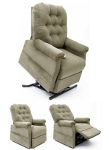One fact that is often misunderstood about arthritis is that there is no way to cure the disease completely, nor can the effects of arthritis be reversed.
Many companies sell miracle cures, like nutritional supplement, copper bracelets, or magnets, touting a cure of the disease, but they are typically selling a fake product. In most cases, these are scams, praying off those who are hurting and relying on the placebo effect to show any sort of effect.
Since there is so much bad advice out there, it is essential to discuss any treatment with your doctor first, even the ones we discuss below!
Treating Arthritis Joint Stiffness
One of the main factors of arthritis is stiffness around the joints. Often, this is complicated by the arthritis patient keeping their joints immobile as a protection against pain, which can often result in a sort of pain circular action, whereby remaining immobile to prevent pain, only makes it more painful and stiff.
One of the most effective ways to prevent stiffness, as well as deal with arthritis pain is to remain active, preforming regular low impact exercises. Low impact exercises include things like walking or swimming and can have a major impact on stiffness, as well as reducing joint pain.
In patients who are obese and have osteoarthritis, exercise can also, when coupled with a healthy diet, help reduce weight, which has been shown to significantly decrease the effects of osteoarthritis.
Managing Arthritis Pain
Stiffness, pain, and inflammation often go hand in hand with those who have arthritis. Regular safe exercise can also have a major impact on joint pain, in part by strengthening the muscles around the affected joint.
However, a big part of pain reduction also comes from determining the types of tasks that cause arthritis pain in the first place and then finding alternative ways of preforming these tasks.
For example, if something like cooking or doing the dishes results in hand pain, then finding ways to still cook or clean, but do so in a more arthritis friendly manner is essential. In many cases, this will involve avoiding the task all together, but as is the case with something like cooking, it can not be completely avoided, so it is necessary to learn to live with arthritis, finding ways of making this much easier.
One way that people do this is by using tools designed to make life easier for arthritis suffers. In the kitchen and around the home, often using items with larger easier handles, as well as things like can openers that automate common tasks can have a powerful impact.
A Word About Exercise and Diet
Studies have found that staying healthy is essential to dealing with arthritis pain, as there is no cure for arthritis. Diet and exercise play an essential role in keeping the body healthy and even just a small amount of weekly safe activity or exercise can have a noticeable impact on arthritis pain.
This is especially true of those who are overweight, as this is one of the leading causes of osteoarthritis, also know as wear and tear arthritis. By reducing weight and eating healthy, studies have found most osteoarthritis patients will see a noticeable reduction in joint pain.
However, it is also important to only preform safe exercises, which is why you should always discuss all treatments with your physician. Sports and exercises that are high impact, like running or soccer, actually increase the risk for arthritis and can cause joint pain, so it is important to not only be careful of what sports are preformed, but also how often they are preformed.
 Osteoarthritis is the most common type of senior arthritis and is a type of degenerative arthritis.
Osteoarthritis is the most common type of senior arthritis and is a type of degenerative arthritis. Lift chairs can be powerful tools that make it easier for seniors to get around their own home, vastly improving independence to the elderly. For many who have difficult standing, it is not moving around that presents the biggest hurdle, but rather getting up in the first place. Lift Chairs provide a safe way for the senior to carefully stand-up and get out of the chair, without assistance.
Lift chairs can be powerful tools that make it easier for seniors to get around their own home, vastly improving independence to the elderly. For many who have difficult standing, it is not moving around that presents the biggest hurdle, but rather getting up in the first place. Lift Chairs provide a safe way for the senior to carefully stand-up and get out of the chair, without assistance. The following are some of the advantages of using a lift chair for a senior.
The following are some of the advantages of using a lift chair for a senior. Elderly individuals, including those with arthritis, often find that there are a number of factors that can make preforming the task of standing up difficult. It is not uncommon for them to ask for assistance when getting out of a sitting chair, such as a recliner. In order to make this task easier for the elderly, using a lift chair is one alternative.
Elderly individuals, including those with arthritis, often find that there are a number of factors that can make preforming the task of standing up difficult. It is not uncommon for them to ask for assistance when getting out of a sitting chair, such as a recliner. In order to make this task easier for the elderly, using a lift chair is one alternative.